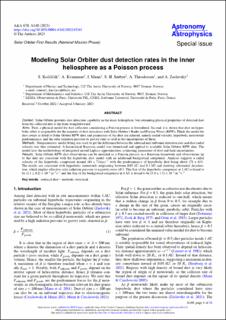| dc.contributor.author | Kociscak, Samuel | |
| dc.contributor.author | Kvammen, Andreas | |
| dc.contributor.author | Mann, Ingrid | |
| dc.contributor.author | Sørbye, Sigrunn Holbek | |
| dc.contributor.author | Theodorsen, Audun | |
| dc.contributor.author | Zaslavsky, Arnaud | |
| dc.date.accessioned | 2023-02-22T07:06:16Z | |
| dc.date.available | 2023-02-22T07:06:16Z | |
| dc.date.created | 2023-02-06T07:15:02Z | |
| dc.date.issued | 2023 | |
| dc.identifier.issn | 0004-6361 | |
| dc.identifier.uri | https://hdl.handle.net/11250/3052937 | |
| dc.description.abstract | Context. Solar Orbiter provides dust detection capability in the inner heliosphere, but estimating physical properties of detected dust from the collected data is far from straightforward.
Aims. First, a physical model for dust collection considering a Poisson process is formulated. Second, it is shown that dust on hyperbolic orbits is responsible for the majority of dust detections with Solar Orbiter’s Radio and Plasma Waves (RPW). Third, the model for dust counts is fitted to Solar Orbiter RPW data and parameters of the dust are inferred, namely radial velocity, hyperbolic meteoroids predominance, and the solar radiation pressure to gravity ratio as well as the uncertainties of these.
Methods. Nonparametric model fitting was used to get the difference between the inbound and outbound detection rate and dust radial velocity was thus estimated. A hierarchical Bayesian model was formulated and applied to available Solar Orbiter RPW data. The model uses the methodology of integrated nested Laplace approximation, estimating parameters of dust and their ncertainties.
Results. Solar Orbiter RPW dust observations can be modeled as a Poisson process in a Bayesian framework and observations up to this date are consistent with the hyperbolic dust model with an additional background component. Analysis suggests a radial velocity of the hyperbolic component around (63 ± 7) km s−1 with the predominance of hyperbolic dust being about (78 ± 4)%. The results are consistent with hyperbolic meteoroids originating between 0.02 AU and 0.1 AU and showing substantial deceleration, which implies effective solar radiation pressure to a gravity ratio ≳ 0.5. The flux of the hyperbolic component at 1 AU is found to be (1.1 ± 0.2) × 10−4 m−2s−1 and the flux of the background component at 1 AU is found to be (5.4 ± 1.5) × 10−5 m−2s−1. | en_US |
| dc.language.iso | eng | en_US |
| dc.publisher | EDP Sciences | en_US |
| dc.rights | Navngivelse 4.0 Internasjonal | * |
| dc.rights.uri | http://creativecommons.org/licenses/by/4.0/deed.no | * |
| dc.title | Modeling Solar Orbiter dust detection rates in the inner heliosphere as a Poisson process | en_US |
| dc.title.alternative | Modeling Solar Orbiter dust detection rates in the inner heliosphere as a Poisson process | en_US |
| dc.type | Peer reviewed | en_US |
| dc.type | Journal article | en_US |
| dc.description.version | publishedVersion | en_US |
| dc.source.volume | 670 | en_US |
| dc.source.journal | Astronomy and Astrophysics (A & A) | en_US |
| dc.identifier.doi | 10.1051/0004-6361/202245165 | |
| dc.identifier.cristin | 2123127 | |
| dc.relation.project | Norges forskningsråd: 262941 | en_US |
| dc.relation.project | Tromsø forskningsstiftelse: 19_SG_AT | en_US |
| dc.source.articlenumber | A140 | en_US |
| cristin.ispublished | true | |
| cristin.fulltext | original | |
| cristin.qualitycode | 2 | |

